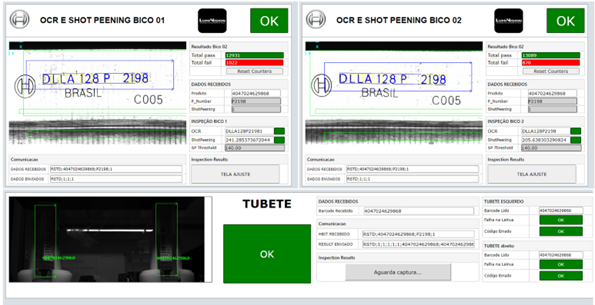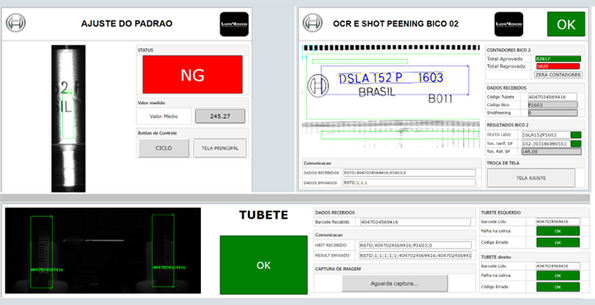Reject rates limited to less than 5% of output with Matrox Design Assistant X-based vision inspection system
Stronger Outcomes for Automotive Component Machining with Enhanced Vision System
Case Study from | Matrox Imaging
Leading global supplier of technology and services, the Bosch Group has been a major player for more than a century. With divisions worldwide, its operations are focused on four distinct business sectors: mobility solutions, industrial technology, consumer goods and energy and building technology. At the Bosch outpost in Curitiba, Brazil, the company’s primary focus is on developing solutions for the diesel engine injection systems for the automotive industry. Its customer base consists of multinational companies working with diesel, as well as off-road and commercial vehicles companies.
When it comes to the manufacturing of Bosch’s diesel injector nozzles, the process involves the operator selecting the specific parts to be produced, then feeding those components into the machine for production; once completed, the operator withdraws the inspected and packaged parts. These injector nozzles are a critical engine component, working to move diesel fuel into the engine’s combustion chamber for vehicle propulsion. The team at Bosch uses vision technology for traceability and verification purposes, as the design and quality of these components is of utmost importance.
At the request of the production line team, Bosch sought out an enhanced vision system, wanting to improve the mark-reading and verification process, as well as the traceability of the injector nozzles. The aim was to reduce the number of machined parts requiring post-production manual inspection. “We had the opportunity to further automate the inspection process,” says Moises Santana, vision system designer with Bosch, “and found that the hardware and software offered by Matrox® Imaging afforded the best option. The new system can handle three independent processes simultaneously using the same computer.”
The newly updated vision system comprises a quad-input Matrox Concord PoE frame grabber and a Matrox Indio I/O card inside an industrial PC with an Intel® i7 core running Matrox Design Assistant X software, which controls the whole system. Three front light bars from LumiVision ensure adequate illumination. An industrial KUKA robot correctly positions the metal components so they can be photographed by the three GigE Vision® cameras from Teledyne Dalsa; after the image capture, the robot repositions the injector nozzles further down the line.
“There are so many good reasons that led us to acquire the Matrox Imaging vision system,” notes Santana. “The software tools are remarkably agile. It is a flexible vision system capable of working with several models of GigE Vision and USB Vision® cameras.”
Putting Pedal to Metal
The three GigE cameras form an integral part of the vision system: two perform optical character recognition (OCR) and optical character verification (OCV) of a code on the nozzles themselves, while the third reads the barcode label affixed to the outside of the packaging tube that encloses the final product. Bosch needed the precision of machine vision technology to read the human-readable codes engraved on the cylindrical metal surface after the shot-peening process.
The robot works in the “feeding station”, collecting the injectors and feeding them to the vision system where they are inspected and verified.
A clever element of Bosch’s system is how it uses an area scan camera—rather than a line scan version—to scan the cylindrical injectors. This process involved collecting a series of images of each nozzle as it rotates, and then stitching the center stripe of each image together to create an unwrapped, flattened picture.
Once unwrapped, the numerical codes in each image can then be read using the StringReader step in Matrox Design Assistant X software. This approach allowed the Bosch team to reduce its setup time, simplify its installation and reduce costs. “We used a combination of software steps for this project, including CircleFinder to locate shapes and StringReader for character recognition,” Santana says, “as well as a number of image filters and customized tools to send and receive images to external applications.”

Web-based Operator View showing the three inspections running simultaneously: Two cameras perform OCR on two injectors, and one camera reads the barcode on the tube packaging, verifying it against the desired format detailed in the software. Results are communicated to a PLC that controls the manufacturing and verification process.

Screen showing the necessary adjustments to build unwrapped image with segments of injector cylinder.
Showing the robot at work placing the injector nozzles in labeled plastic tubes. At this point, the Matrox Imaging vision system performs barcode reading and verifying against a PLC recipe for identification.
“The graphical interface in Matrox Design Assistant X is friendly to use,” Santana continues, “as well as the online training through its on-demand platform. We also received great technical support from Sensor do Brasil, Matrox Imaging’s representatives in Brazil. All in all, the Bosch team felt supported the whole way through.”
Using the flexible Matrox Design Assistant X software, the team at Bosch was able to effectively pack three inspection and verification processes into a single vision system, which significantly decreased the overall system cost.
A Silver Bullet Solution
Building the vision system took about one month, a tremendous feat for a system of this complexity. The system itself is simple to operate; a single machinist, with no prior machine-vision expertise, can easily manage the operation.
The Brazilian Bosch office was pleased with the self-directed learning through the Matrox Vision Academy training platform; its team also requested application-development support, specifically with regards to creating a montage of the flattened images using Matrox Design Assistant X and to configure communication with the programmable logic controller (PLC). Santana smiles, noting that “the response time from the Matrox Imaging support team was appropriate and competent.”
Conclusion
With the new vision system online, Bosch is already looking to add an additional two cameras to the process, to inspect defects on the surface of the injector nozzle and replicate the solution to a second machine. “We anticipate developing future projects using a similar vision system,” Santana says, “We see additional applications using artificial intelligence (AI), incorporating Matrox Imaging smart cameras as well.”
The Brazilian Bosch team found Matrox Design Assistant X to provide both the flexibility and ease-of-use it hoped for, especially with the range of branded and third-party hardware that makes up the system. Santana affirms, “The level of technical support available locally in Brazil as well as from Matrox Imaging HQ, plus the accessibility of online training was incredibly advantageous. From acquisition to analysis and processing of images, everything was smooth, and had the possibility of real-time visualization, really making this a solution that satisfies the exceptional quality standards of Bosch’s products.”
Using the new Matrox Imaging vision system, the Curitiba plant achieves production volumes of 7,000 parts per day and has decreased the daily percentage of false rejects to 5%, a significant improvement over previous iterations.
For more information contact Media Relations.
The content & opinions in this article are the author’s and do not necessarily represent the views of RoboticsTomorrow
Featured Product

AUCTION - FACILITY CLOSURE - MAJOR ROBOTICS AUTOMATION COMPANY
BTM Industrial is a leading asset disposition company assisting manufacturing companies with their surplus asset needs. Founded in 2011, it is a fully licensed-and-regulated, commission-based auction and liquidation company. The company's full asset disposition programs provide customers with the ability to efficiently manage all aspects of their surplus and achieve higher value.
